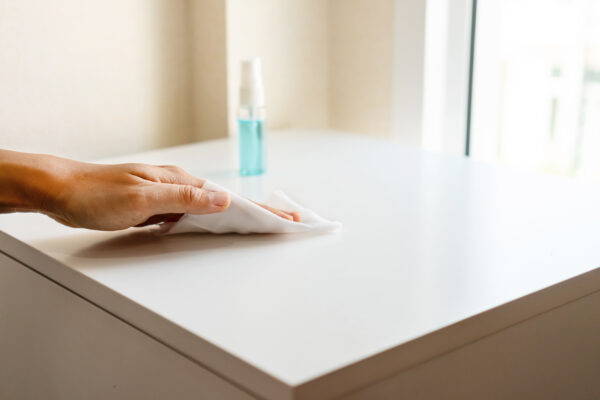
Effective surface disinfection is essential to prevent Hospital-Acquired Infections (HAIs) and ensure a safe treatment space for patients and caregivers.
Manual cleaning is often at the forefront of these efforts, as care providers and Environmental Service Technicians (EVS) work diligently to clean and disinfect surfaces. In a seemingly never-ending quest for greater efficiency and higher effectiveness, many healthcare providers use disposable wipes, believing these throw-away products are best positioned to elevate their disinfection strategies.
Unfortunately, these efforts aren’t always as effective as providers might think (or hope). In principle, the idea of one wipe, one surface, one direction seems simple. In practice, it’s significantly more complicated.
The Challenges With Disposable Wipes
Concentration
Disposable wipes are only as effective as their disinfectant materials, requiring precise saturation to ensure optimal outcomes. As one study found, several variables influence efficacy, including disinfection type and concentration.
In practice, disinfectant concentration is critical but unpredictable. For instance, frequently opening and closing a container of wipes dries out the material over time, and the last wipe in a container will be significantly less saturated with disinfectant than the first one.
Contact Time
Surface contact time, which is the duration that a disinfectant needs to remain wet on a surface to eradicate infectious disease effectively, varies significantly depending on the product and pathogen.
These specifications are often precise, and ensuring fidelity to prescribed standards can be challenging because of the constant demand for quick room turnovers and the potential for human error.
Using disposable wipes doesn’t ensure that these standards will be met. In fact, the frequent lack of precision with disinfectant concentration and usage guidelines makes it clear that disposable wipes aren’t the “magic bullet” that many healthcare providers wish they were because they don’t ensure that surface contact time standards will be met, undermining their efficacy in the healthcare setting.
Human Error
While disposable wipes are convenient, they don’t eliminate the human element. AORN reports that EVS personnel tasked with manual cleaning frequently forget to clean around entire surfaces, missing cracks, crevices, and the undersides of objects. Additionally, soft surfaces like curtains, fabric chairs, and linens are frequently neglected.
As the American Journal of Infection Control reports, “only 40% of near patient surfaces are being cleaned in accordance with existing hospital policies.”
Recontamination
At the same time, personnel are prone to using a single wipe beyond its disinfection capacity, undermining the “one wipe, one surface, one direction, dispose” mantra that accompanies manual cleaning with disposable wipes.
A study by the National Library of Medicine notes that while wiping a high-touch metal, ceramic, or plastic surface to remove bacteria is an acceptable tool in combating the transmission of HAIs, actual wipe usage often undermines these objectives.
The publication explains, “In practice, surfaces may be repeatedly wiped using a single wipe, and the potential for recontamination may be affected by various factors.”
Consequently, as the National Center for Biotechnology Information reports, “Cross-contamination among surfaces following terminal cleaning alone was documented in 50% of the total samples.”
A Deceptively Complex Process
Hard working EVS teams often don’t realize how many directions must be followed precisely for best results. Add to that the complexity of dilution rates, dilution errors, and outside factors like human error, and it’s easy to see why disposable wipes are often much less effective than many healthcare providers think.
Ultimately, as one analysis notes, “Manual surface cleaning isn’t completely effective. Your staff can’t eliminate every pathogen, no matter how much elbow grease they apply and the diligence they display.”
The Risks of Improper Disinfection
This is much more than an inconvenience. When used improperly, disposable wipes inject new challenges into the disinfection process, resulting in insufficient or non-compliant wipe usage, pathogen transfer, cross-contamination, HAI proliferation, and other risks.
The bottom line is simple: disposable wipes are a lot more difficult to use effectively than people think. Instead, an effective disinfection regime demands a multimodal approach, combining intermittent manual cleaning with whole-room disinfection technologies that streamline the disinfection process and elevate results.
The Case for Whole-Room Disinfection Technologies
The motivation behind disposable wipes is laudable. Faster, more effective disinfection benefits healthcare providers and their patients. Whole-room disinfection technologies have proven results in this regard, including reducing turn times and mitigating SSIs.
According to a study published in Critical Care Explorations, manual cleaning alone took EVS teams more than 18 minutes, while modified cleaning protocols involving automated solutions and manual terminal cleaning took just 6.5 minutes of human input to complete.
The study also concluded that when tandem protocols were used, including abbreviated terminal cleaning and whole-room atomized disinfection, healthcare providers saw a 64 percent improvement in manual labor efficiency.
Nevoa’s fogging technology is groundbreaking in this regard, providing EVS teams with a flexible disinfection solution that elevates patient safety. The fogger kills 99.9999 percent of pathogens in just one minute, including Staph, MRSA and Pseudomonas — the leading causes of SSIs.
Every Patient Deserves Advanced Disinfection
Efficient, effective surface disinfection isn’t just a logistical issue for healthcare providers. It’s a moral imperative and an operational necessity. At Nevoa, we know that you want to provide the safest possible environment for your patients and staff.
That’s why we believe in the power of incorporating advanced disinfection technologies alongside traditional methods. The use of disposable wipes, while beneficial for quick cleanups and addressing high-touch surfaces, should not be the sole strategy for infection prevention.
To discover how Nevoa can transform your facility’s disinfection practices with a cost-free trial, contact us today and take the first step towards a safer healthcare environment.
